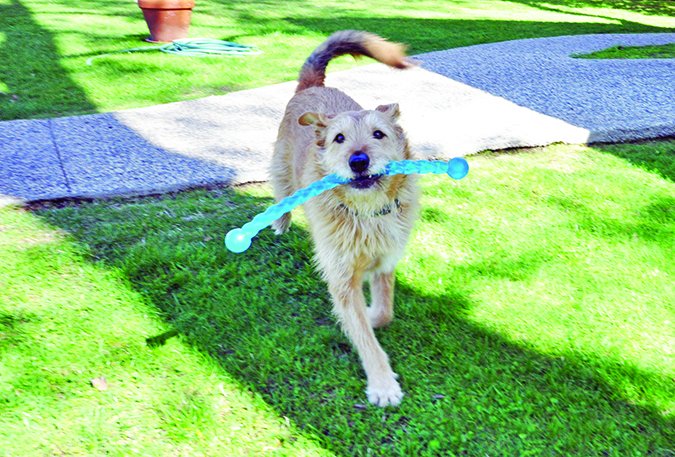As any puppy owner knows, dogs are naturally oral creatures. Seems like a retrieve should, therefore, be an easy behavior to teach. Indeed, it sometimes is, but as many dog owners know, it often is not. Reasons a dog might not fetch naturally include:
1. The dog was punished as a puppy for picking up/chewing on things and therefore his oral tendencies have been suppressed.
2. The dog has been chased for picking up things and therefore plays keep away instead of bringing things back.
3. The dog is of a breed that has not been genetically programmed to bring things back to their humans (think terriers versus sporting and herding breeds).
There are many reasons to persevere in teaching even the most reluctant retriever to retrieve, however. A dog who retrieves can:
1. Be easily exercised and amused with long sessions of fetch in the backyard, or even in the house in inclement weather. Exercise is a great behavior modifier; a tired dog is a well-behaved dog – and makes for a happy human.
2. Learn to find and bring back lost objects.
3. Compete in obedience trials and other canine competitions.
4. Learn to do other things with his mouth, including service dog-type behaviors such as opening doors, picking up dropped objects, pulling wagons, carrying groceries, removing items of clothing, and more.
5. Engage in cognitive activities such as object and location discrimination.
When a dog loves to retrieve, the behavior can be used as a powerful non-food reinforcer, as well as a tool for keeping the dog’s attention around distractions, and for getting really sharp recalls and other operant behaviors. A highly valued tennis ball can be a great reinforcer – for some dogs, a ball is even more valuable than food! – for spiffy recalls and downs, among other behaviors. These are all great reasons to help a dog love to retrieve!
Formal Dog Retrieval and Informal Fetch
There are different types of retrieves. The majority of dog owners are happy with a dog who dances in anticipation of the ball, chases after it the instant it’s thrown, maybe runs around with it for a bit, then eventually brings it back at and drops it at the owner’s feet. We’d call this an informal game of fetch.
Compare that to a formal show retrieve, where the dog is supposed to sit motionless in perfect heel position while the owner throws a dumbbell, dash forward when the owner gives the cue, grab the dumbbell cleanly by the center bar, return quickly to the owner, and sit in front, perfectly straight, waiting for his owner to give the cue to release the object carefully into her outstretched hands. “Canine Sports: Competitive Obedience,” (July 2010) goes into greater detail on what is required for the show ring.
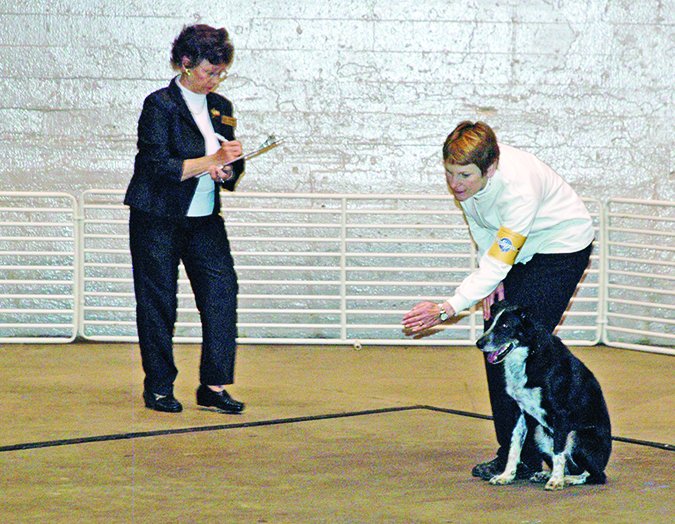
Even if you’re not interested in a formal retrieve, consider taking advantage of a good game of fetch as an opportunity to reinforce good manners behavior. Consistently ask your dog to “sit” before you throw the ball, until he starts offering to sit without being asked. “Sit” makes good things happen! It’s also a deference behavior, and good “self-control” practice. When he’s consistently offering a calm sit before you throw the ball, try building a similar routine to get him to offer a calm “down” before you throw the ball.
You can also use a valued fetch toy to install an off-switch for your dog. When it’s time to stop the game, use a cue like “All done!” or “That’s all!” and immediately put the ball where he can’t see it, such as in a pocket, a drawer, or a cupboard. Turn and walk away – totally ignoring any attempts on the dog’s part to re-engage you in the game. In time, your “All done!” cue will not only serve notice to your dog that the fetch game is over, but also indicate the end of other behaviors.
Whether you’re interested in an informal fetch or a formal retrieve, your task will be easier if you encourage rather than discourage retrieve-related behaviors early in your relationship with your dog. When he has something in his mouth, praise him; tell him he’s a good dog! If it’s something he’s allowed to have, you can sometimes praise him and let him be, and other times, you can say “Trade!” and trade him a treat for the item. Or, trade him a treat for the item, and then give him the item back again. That’s quite a reward!
But if, in contrast, he has something in his mouth that he shouldn’t have, cheerfully trade him for a high-value treat, divert his interest to a “legal” toy, and make a mental note to increase your management efforts to minimize his access to those things you don’t want him to have.
Shaping Your Dog’s Retrieve
Whether your dog is a natural retriever or not, the training process is the same. It’s just a matter of shaping the retrieve you want. If you’re going for a formal retrieve, it’s a matter of chaining or backchaining the “fetch” behavior into the whole show-ring retrieve routine. (See “Fun Dog Training Techniques Using Shaping,” (March 2006), and “Beyond Basic Positive Dog Training Techniques,” (April 2004).
Since the “hold” tends to be the most challenging part of the retrieve, we’ll start with shaping that behavior and work our way backward (backchain) to the completed fetch behavior.
You can indicate to your dog precisely which behavior will result in his receiving a treat or other reward by “marking” the moment with a clicker, using your mouth to make a clicking or clucking sound, using a verbal marker (such as the word “Yes!”), or by using an i-Click (a clicker with a raised button), positioned so you can click it with an elbow or a foot. Just be aware that if your clicker is in your hands, you may frighten your dog by clicking too close to his face. You definitely do not want to give him an aversive association with the retrieve game!
Remember, each time you mark a behavior, you need to deliver a treat pretty quickly afterward. The marker is a promise that a reward is on the way, and it gives the dog solid, instantaneous information about what behavior he can repeat in order to earn more rewards.
In Whole Dog Journal, we often use the phrase “click/treat” or “mark/treat” as shorthand for using a marker of any kind and then giving the dog a food reward.
Okay, ready? Designate your dog’s most favorite toy as his fetch object. Hold it in both hands and offer it to him, rather than throw it. If he sniffs it, mark that desired behavior with a click! (or your alternate marker) and give him a reward. If he merely glances in the object’s direction, mark the glance and give him a reward.
In the beginning, reinforce your canine pal just for paying attention to the object. In any series of “attention” trials with the fetch toy, sometimes he’ll sniff or touch it, sometimes he’ll just look at it, and sometimes he’ll put his mouth on it. Once he understands the game, you can up the ante (this is called “raising the criteria”); you mark the behavior and give him a treat only if he touches it. Then, later, you mark/reward only if opens his mouth (even slightly), and eventually, only if he actually puts his mouth on it, then for longer periods of “mouth on object.” (Of course, he will let go of the object to eat the treat after you click or use your alternate marker!)
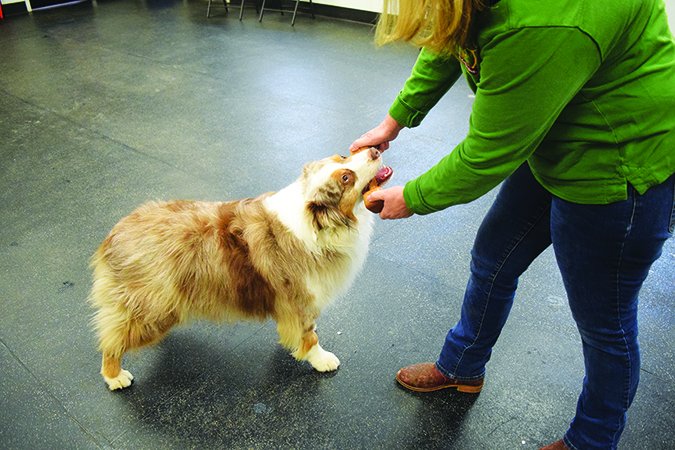
When he will hold his mouth on the object for five seconds or longer, briefly remove your hands and then grasp the object again. Mark the behavior and give him a treat when your hands touch the object. Repeat, gradually increasing the length of time your hands are off the object. Remember to mark/treat when you replace your hands on the object.
The next step is to move your hands a few inches away from the object, and click/treat your dog for moving the object to your hands, eventually increasing the duration the object is in your hands before you mark and reward this behavior. The duration of the hold is important for a solid retrieve! When you have several seconds of duration, start varying the duration so your dog doesn’t anticipate the release and let go too soon.
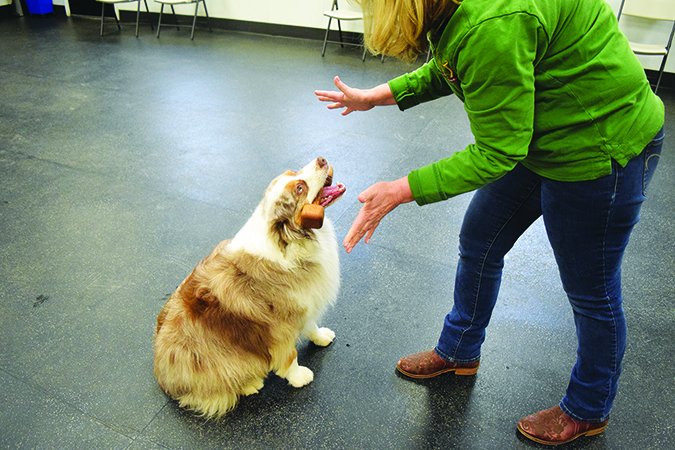
Now place the article on the floor with your hands on it. If you’re lucky, your dog will transfer his mouth/hold behavior immediately to the object on the floor. If not, back up and use the same shaping process you just used to get the dog to hold the article to get him to put his mouth on it on the floor. (With the article on the floor, click/treat him for looking at or sniffing the article, and build again from there.) When he will mouth the object, move your hands a few inches away, and have him deliver it to you. Remember to vary the amount of time (duration) that you hold your hands on the object before you click/treat.
Next, gradually increase the distance between the article on the ground and your hands until your dog is picking the object up and delivering it to you from a few feet away.
(Have you noticed that I haven’t told you to add any cues yet?)
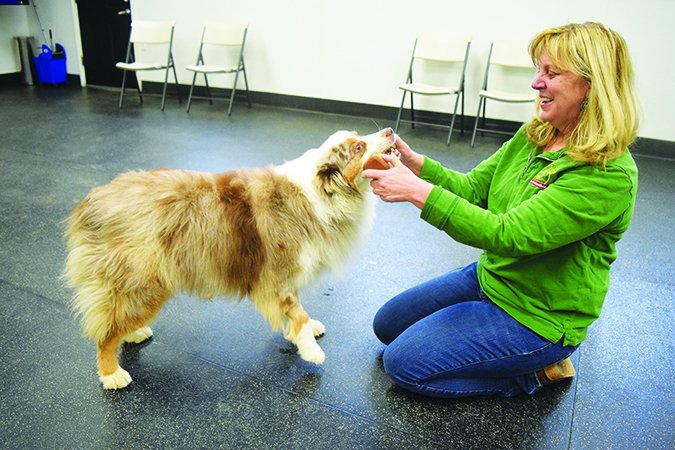
Next, start tossing the article a few feet and letting your dog go get it and bring it back. After a few successful toss/retrieves, ask your dog to wait (hold him gently if necessary) while you sometimes place, sometimes toss the article a few feet away. Return to his side, wait a few seconds, then release him to retrieve the object. (Vary the duration that you wait before releasing, just as you continue to vary the duration of the hold before you click and treat.)
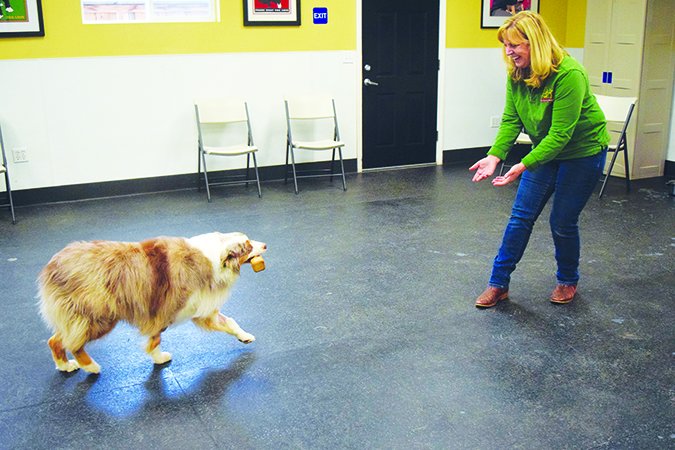
When your dog is routinely picking up the object, bringing it back to you, and reliably holding it until you click/treat, add your verbal cue of “Fetch,” “Take it,” “Get it,” or whatever you plan to use. First give the cue just as the object touches the ground. When he will reliably dash out to get it and bring it back, add the “Wait!” back in (hold him if necessary), and vary the amount of time between the toss and the “Fetch!” cue.
You’re almost done. The next step is to add your “Give” cue to replace your marker (click, “Yes!” or what have you) as his signal to let go of the object. It’s important to continue to vary the duration of hold after your hands touch the article, as it’s easy for hands-touching-article to become a default cue to release – and you don’t want that! When your dog retrieves the object, grasp it with your hands, wait, say your “Give!” cue, and then click/treat.
Eventually – probably pretty quickly – you will be able to fade the marker and your dog will release the object on cue. At this point, if you’ve done your job well, your dog will love retrieving so much that you can reinforce the retrieve with the opportunity to fetch again.
The final step is to generalize the retrieve to other objects. Start back at the beginning of the shaping process as needed and work your way (probably much more quickly with each new object), first with other toys and articles the dog is likely to pick up, and eventually with more challenging objects like your keys and the TV remote.
Don’t forget to keep it fun! This should be the best game in the world for your dog. If at any time he “quits” – that is, he stops playing the game – you may have raised the criteria too quickly, or you may have trained for too long. Training sessions should generally be five to 15 minutes in length, several times a day (although some dogs have a strong work ethic and will happily work longer). Remember that it’s always better to stop when you and your dog are having fun and winning, rather than when one or both of you are bored, tired, or frustrated.
Teaching Your Dog a Cognitive Retrieval
For a real training challenge, add a cognitive piece to your dog’s retrieving abilities: object discrimination. Name each new object as you add to his repertoire of fetchable items. As you present it to him, use the object’s name. “Ball.” “Kong.” “Frisbee.” “Snake.” You will need to get creative with names as you add more objects to his list – and write them down so you don’t forget them. Then, when you give your “Fetch” cue, also name the object that you are asking him to retrieve. “Ball, Fetch!” “Snake, Fetch!” “Frisbee, Fetch!”
When your dog’s retrieve is very solid with individual named objects, you’re ready for the cognitive part. Place one object (say, a Frisbee) a foot away from him. Place another object (say, a snake) about six feet away. Cue him to “Frisbee Fetch!” (the closer object). As long as he retrieves the correct object, gradually move the closer object (in this case, the Frisbee) farther away, until it is also six feet away from you – and several feet to the side of the other toy (in this example, the snake).
If he starts making mistakes, you’ve moved too quickly. Bring the Frisbee back closer and continue. When he is at least 80 percent reliable with the Frisbee and the snake, put those two items away and bring out two more. Repeat the same routine – one close, one far away, until he’s getting it right. As he gets better at it and understands the concept of objects having names, you can add multiple objects and ask him to get one, then a different one. Take it slow! This is PhD work for you and your dog.
Want another cognitive retrieve challenge? Teach your dog the names of the rooms in your house. Take him into the kitchen and say, “Kitchen!” Repeat several times. Then stand outside the kitchen, say “Kitchen!” and run with him into the kitchen. Click and treat. Repeat until he will run into the kitchen without you when you say, “Kitchen!” Now repeat with other rooms in your house until he will run to any room you name. Next step: Add the retrieve. Have him wait outside the kitchen, and set the ball in the kitchen where he can see it. Return to him and tell him “Ball, Kitchen, Fetch!” Repeat with different objects from greater distances – and in different rooms, until he will fetch an object from any room you designate.
Want to get really fancy? When he’s really good at each of the above cognitive retrieves, combine the two. Place two (and eventually multiple) objects in another room and cue him to fetch one. Perhaps the snake and Frisbee are in the bedroom, with the snake closer to the door at first (remember to set him up to succeed!). Tell him “Snake, Bedroom, Fetch!”
With time and success, you can work your way up to object discrimination with multiple items in various rooms all over the house. Who knows, maybe your dog can rival the accomplishments of the brilliant and notable Border Collie, Chaser, who knows the names of more than 1,000 objects and can perform incredible feats of cognition. If not, the two of you will still be having a ton of fun together!
Thanks to trainer Sarah Richardson of The Canine Connection, in Chico, California, for modeling for this article.
Author Pat Miller, CBCC-KA, CPDT-KA, is WDJ’s Training Editor. She and her husband Paul live in Fairplay, Maryland, site of her Peaceable Paws training center, where Pat offers dog-training classes and courses for trainers. Miller is also the author of many books on positive training. Her newest is Beware of the Dog: Positive Solutions for Aggressive Behavior in Dogs (Dogwise Publishing, 2016).


